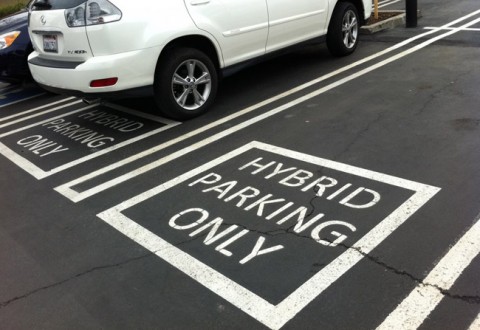What if parking spots and lots just started to slowly disappear and you were more inclined into taking the light rail train, bus or ride a bike out of sheer convenience. Well that’s exactly what the city of Copenhagen has been doing for the past 40 years. Each year they have been cutting down on the percentage of parking garages, large parking lots and curbside parking in hopes that it will encourage people to use public based transportation, walk or bike to their destination.
According to research done in Paris, people decide how they will travel based on what kind of parking is available at their destination. In theory, this was done to help cut down on traffic emissions and air pollutants by just eliminating easy access to parking. Thus, fewer cars would be on the road resulting in cleaner air for everyone. I can already envision how that might stir up quite a controversy among regular commuters and the non-environmentally friendly crowd. Conceivably raising parking meter and parking lot fees could fuel a picketing frenzy. So what can or will North America do?
Parking Reform in Portland
Well some US cities already have curbed the idea of driving cars in general. In Portland, Oregon there seems to be a trend of “it’s not cool to even OWN a car.” If you are an avid cyclist in Portland, than you are considered hip and would likely be part of a growing bicycle community. It is a tremendously different perception out here in the San Francisco Bay Area. All we see is traffic and smog as far as the eye can see. Many Bay Area folk hang their social status on how big their house is and what kind of car they drive. Maybe that’s just a silly stereo type. Often time’s people lead by example. I think that the Bay Area certainly has taken the reign in certain areas of sustainability and green thinking but I feel they have a long way to come. Other cities need to adopt similar attitudes towards this subject matter.
The society we live in is a “car culture.” Finding ways to change that can and should be done. Cities can plan for infrastructures to be built to make it easier for the public to make the transition. A new foundation such as bike lanes or wider sidewalks should be created in place of removed parking spaces in downtown areas, for example.
Parking Reform in Paris
Paris has made quite some head way in parking reform. Since 2003 they have reduced street side parking spaces by 14,300 spots which is about 9%. They reestablished parking to underground facilities and started to charge for it. Policies like this can either work or not sometimes. “On the one hand, a shortage of car parking supply, can motivate people to get out of their cars and onto the sidewalk or bike lane” Sareco researchers explained. Yet an imperfect system can also increase traffic congestion caused by circling for on-street parking.
If you know there is not ample parking available when you plan to go shopping then are you more likely to just head out to a place that has parking spaces so abunduntely available free of charge? I suppose there are several factors that are in play when applying new policies in downtown urban areas. A mixture of easily accessible public transportation and parking regulations in a wider area could make people opt for the easier choice which would be to leave those car keys at home.
Parklets Spawn from Parking Issues
Other small incentives that people may actually enjoy and get use out of are called “parklets.” For the green conscious, that may be a new term you may not have heard of. Parklets are geared and designed for the casual passerby in a downtown urban area to stop and chill out for awhile. They are mini urban parks that have taken the place of a once street side parking spot or two. But they can be as long as a few blocks. You will usually see a set of tables and chairs, potted plants, trees, benches and bike racks. These parklets are becoming more and more popular in big cities like San Francisco and New York. People love hanging out, drinking their coffee, chatting, and people-watching as they enjoy the atmosphere. They are meant to be pedestrian and bicycle friendly and could definitely help with the idea of promoting car-free transportation.
Such car polluted cities like Los Angeles, Washington D.C, and San Francisco have started to think about ways to focus on addressing air pollution. San Francisco has gone where not many cities have gone by instituting parking maximums opposed to parking minimums in some areas. In the past some cities have tried to manage parking as a way to cut down on air pollution under the US Clean Air Act. With the growing concern of climate change, mayors and cities are starting to take notice by trying to enforce new policies as well as think of ways to offer people better alternatives than driving cars.
Changing the “car culture” concept would not be an easy thing to do. But the ideas are there and certainly are spreading around. It would be a wonderful thing if people were more open to the idea of car free transportation in their everyday life. I think that other modes of transportation can and should become part of the “norm.”
Photo credit: Some rights reserved by Cafemama on Flickr.
Photo Credit: Some rights reserved by jeremyashaw on Flickr.




